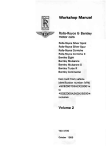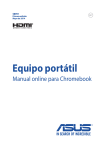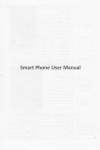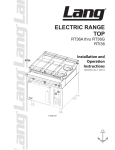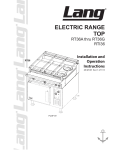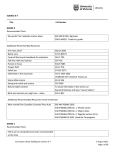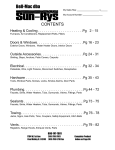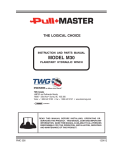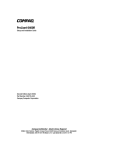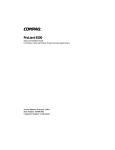Download Utile LW825 Operating instructions
Transcript
Installation Operation Maintenance Instructions Model LW625 – LW825 Blower / Vacuum Pump with manual 4 way valve Serial Number Site Location Installation Date The Utile Engineering Co. Ltd. Irthlingborough, Northamptonshire. England Tel: +44 (0) 1933 650216 Fax: +44 (0) 1933 652738 11/08/06 1 IC154 Contents Foreword Page General …………………………………………………………………………………….. Operating Principle …………………………………………………………………………… 3 3 Health and Safety …………………………………………………………………………… 4 Technical Specification …………………………………………………………………………… Packaging …………………………………………………………………………………….. Storage …………………………………………………………………………………….. 5 5 5 Handling Installation …………………………………………………………………………………….. …………………………………………………………………………………….. 6 6 Pre Start-up Checks …………………………………………………………………………… Start-up …………………………………………………………………………………….. Protective Devices …………………………………………………………………………… 8 8 8 Operating Notes …………………………………………………………………………… Stopping Procedure …………………………………………………………………………… Lubrication …………………………………………………………………………………….. 9 9 9 Maintenance 10 …………………………………………………………………………………….. Troubleshooting Check Blade Wear …………………………………………………………………………… …………………………………………………………………………… 11 11 Blade Inspection …………………………………………………………………………… Reassembly after Blade Inspection ………………………………………………………… Cylinder Renewal …………………………………………………………………………… Change Bearings and Seals …………………………………………………………………. 12 12 12 12 Reassembly …………………………………………………………………………………….. 13 Spare Parts …………………………………………………………………………………….. After Sales Service …………………………………………………………………………… 14 14 Spare Parts List …………………………………………………………………………… 15 …………………………………………………………………………………….. 16 Warranty Warning Read the installation and maintenance information before commencing work on this equipment. Your attention is drawn to the health and safety information on page 4. Until the equipment into which the machine has been incorporated and the said equipment declared to be in conformity with the Machinery Directive, they must not be put into service. Foreword The LW rotary blowers and vacuum pumps have been developed based on many years of experience in the compressor and vacuum pump industry. Using modern design techniques and production methods coupled with rigorous testing and high quality standards ensure these of machines have a long, efficient and reliable service life. These operating instructions have been written for all personnel who have responsibility to the machine, it contains all the necessary information required for the machine to have a long trouble free service life. This manual must be stored near the machine and read before attempting any work on it. Ensure that all operation and maintenance is only performed by competent and trained personnel and any repairs use only original parts from the manufacturer. The Utile Engineering Co. Ltd. Irthlingborough, Northamptonshire. England Tel: +44 (0) 1933 650216 Fax: +44 (0) 1933 652738 11/08/06 2 IC154 General Operating Principle General The normal routine of running the machine is very simple. If it is carried out strictly at all times, many years of trouble free service can be expected. We emphasise two points of paramount importance1. Filtration of incoming air of gas 2. Lubrication If possible provide a logbook so that the operator can enter daily readings. After several months a record will show whether the machine is performing as it did originally. If readings are to be taken the following are all that is required. Inlet and outlet air temperatures, suction conditions and oil drip rate. A typical layout for the log book is shown in the table below. Date Inlet Gas Temp. Machine Log Book Discharge Gas Temp. Inlet Conditions Oil Drip Rate. Operating Principle Rotary sliding vane compressors and vacuum pumps are multi-cell machines, which work on the displacement principle. They provide a constant, low-pulsation supply of air or gas. The machines have a cylindrical bored housing. The rotor, which is also cylindrical, is fitted eccentrically in the cylinder so that a crescent-shaped working chamber is formed. Movable rotor vanes are fitted in the longitudinal grooves in the rotor; centrifugal force and the force of the air or gas presses the blades against the cylinder-housing wall when the rotor turns. The vanes divide the crescent-shaped working chamber into cells of different sizes. As the rotor turns, the cell volume on the intake side increases, and the cell draws air in at low pressure, at which point is open to the intake delivery line. As the rotor continues to turn, the cell is closed (see fig 1) and the volume of the cell decreases. This causes the enclosed air or gas to be compressed (see fig 2) and forced out through discharge delivery line under atmospheric pressure. The machine can only be run in one direction, which is indicated by an arrow on the cylinder. The direction of rotation must not be reversed. Fig. 2 Fig. 1 Discharge The Utile Engineering Co. Ltd. Irthlingborough, Northamptonshire. England Tel: +44 (0) 1933 650216 Fax: +44 (0) 1933 652738 Intake Discharge Intake 11/08/06 3 IC154 Health and Safety Read the installation and operating instructions carefully. Rotating machinery and pressurised components, which may contain toxic, flammable or otherwise hazardous media are potentially dangerous equipment if not operated and maintained correctly. It is imperative that all users of such equipment fully educate themselves to the potential dangers and satisfy themselves that the personnel responsible for installing, testing, commissioning, operating and maintaining the plant are competent to do so. Instruction manuals are provided for guidance but must assume some basic level of competence by users. If there are any doubts or ambiguities concerning correct procedures, ask Utile Engineering. DO NOT TAKE RISKS. Certain machinery can generate high levels of noise which can be harmful if exposed to it for lengthy periods of time. Various codes of practice are in existence and users must ensure that adequate precautions are taken to prevent a health hazard to employees or third party. Equipment with internal pressures above or below ambient pressures can create a hazard. Before attempting to investigate problems, service or maintain equipment, it must be safely depressurised or pressurised to ambient conditions. Also since the gaseous medium may be flammable, toxic, corrosive or otherwise hazardous it may be necessary to purge the installation with an inert gas, such as nitrogen. Special precautions are necessary for certain gases and the user must ensure that adequate procedures are implemented. Moving parts of machinery must not be touched and all such parts must be adequately guarded. Suitable guards are provided and must be securely retained in position at all times. Before commencing maintenance, servicing or making other adjustments, the prime mover and other equipment must be isolated electrically or otherwise immobilised to prevent accidental start-up. In this vein, a fully qualified electrician should carry out all electrical work and all electrical equipment should be isolated before it is touched and pneumatic or hydraulic controls depressurised and made safe. Procedures must also exist to ensure that electrical or other inputs cannot be restored accidentally during the maintenance or service period. Safety trips, emergency stop-buttons and other such devices (if fitted) are to be checked regularly to ensure that they continue to function correctly and will protect the installation and personnel in the event of an emergency. NO attempt should be made to touch the machine whilst it is rotating. Particular care is needed when checking rotor clearances. Any movement of rotors may trap fingers. Most machines, certain pipes and ancillaries become hot during operation whilst certain machines with sub-zero inlet temperatures may result in very cold surfaces. If it is possible for personnel to come into contact with such surfaces unknowingly or accidentally they should be guarded. If severe vibration is observed, the cause of this should be immediately investigated and the situation rectified. Excessive vibration can lead to fatigue and other failures. Similarly, if during operation a significant change is noticed in the level of vibration, noise, temperature or any other parameter, the cause of such changes must be determined, and the cause rectified. Inlet filters must be inspected regularly so that liquid or debris is not allowed to enter the machine, which could cause damage and consequently injury to personnel. During routine maintenance, coupling alignment should be checked for misalignment. Only approved lubricants must be used and quantities, etc must be checked regularly. Before restarting after servicing, all nuts, set screws, etc must be checked for tightness, check all joints, for leaks and carry out purging as necessary before introducing the process gas. Also, before start-up, check the machine inlet and outlet isolating valves are open both non-return valves (if fitted) are the correct orientation. Adjacent pipework and equipment must not impose undue forces and moments on the machinery flanges. All welding work must be carried out be an approved gas coded welder. In order to prevent reverse rotation of machines, it is ESSENTIAL that a non-return valve be installed in the inlet pipework. Otherwise a hazardous situation can arise during a normal shutdown or if the prime mover power supply is interrupted for a period of time. The environment around the installation may need to be monitored in order to detect gas leaks etc., and consideration must be given to the installation of gas detecting equipment, and the class of electric equipment. All personnel working in or passing through the area should be adequately warned by signs and trained to exercise appropriate safety precautions. Ensure the correct personal protective equipment is worn at all times. The Utile Engineering Co. Ltd. Irthlingborough, Northamptonshire. England Tel: +44 (0) 1933 650216 Fax: +44 (0) 1933 652738 11/08/06 4 IC154 Technical Specification Packaging Storage Technical Specification The model, machine serial number, year of manufacture, temperature class and zone rating for the machine appear on the machine data plate, other machine data can be found in the following table. Nameplate Data Logo Gas/Dust Protection Category G – Gas 1–V.High Protection D - Dust 2–High Protection 3–Normal Protection Machine Model eg LW625 Machine Serial Number (Always quote this in correspondence) Equipment Group I – Mines II – Surface Indus Ex Zone Rating Mark 0 – Very High Protection - Gas Area 1 – High Protection - Gas Area Year of 2 – Normal Protection - Gas Area Manufacture Temperature Classification 450°C – T1 300°C – T2 200°C – T3 135°C – T4 100°C – T5 85°C – T6 CE Marking Maximum Pressure Maximum Vacuum Speed – Maximum Speed - Minimum Volume at 1 Bar at Max. Speed (Air) Capacity at 50 kPa at Max. Speed (Air) Absorbed Power at 1 Bar at Max. Speed (Air) Absorbed Power at 50 Kpa at Max. Speed (Air) Maximum Ambient Temperature Surface Temperature at Max. Press. at Max. Speed (Air) Surface Temperature at Max. Vac. at Max. Speed (Air) Moment of Inertia Noise Level at 1 metre Weight Units Bar kPa R.P.M. R.P.M. m3/hr m3/hr kW kW °C °C °C kg m2 db (A) kg Contact address & numbers LW625 2.00 96.5 1200 750 560 603 24.5 15.7 40 170 190 0.41 90 190 LW825 2.00 98.0 1200 750 825 930 31.6 21.8 40 175 199 0.54 90 225 Note: Machine must not be used on any other gas than originally specified. Utile Engineering must be consulted if traces of any other gas are introduced into the machine. Packaging Top / The packaging conforms to the relevant regulations. The symbols used on the This Way Up packages are shown on the right. The machines are bolted down on a pallet and therefore should not move during transportation and either cased or shrink wrapped for general protection. The ancillary components are packed suitably within the case. The packaging and Fragile contents should be received in good condition. When unpacking do not remove the inlet/outlet protection covers. The contents should be inspected against the advice note, notify Utile Engineering within 3 days of any items, which are damaged or are missing, followed by a written claim within seven days of the goods being delivered. Storage If the machine is not required for immediate installation, the machine should be stored in a clean, dry area protected from the weather. The intake and discharge port covers must remain in position until the machine is installed. We recommend that the shaft be turned a few revolutions by hand to ensure the machine is running free every month until the machine is installed. The green protective coating on the shaft remains effective for approximately 1 year. If the machine is stored for a longer period of time, the coat must be renewed. The Utile Engineering Co. Ltd. Irthlingborough, Northamptonshire. England Tel: +44 (0) 1933 650216 Fax: +44 (0) 1933 652738 11/08/06 5 IC154 Handling Installation Handling Skilled personnel working in accordance with safe working practices must carry out the lifting of machines. Before lifting the correct equipment must be available. Cranes, jacks, slings, and lifting beams must be capable of carrying the weight of the machine to be lifted. The lifting eyebolt situated in the top of the cylinder and a crane hook must be used when lifting or moving the machine (see fig 3). Do not use the machine ports or the shaft extension for lifting or moving the machine. Fig. 3 For weights see table in Technical Specification. Installation Before commencing installation, a site specific risk assessment, method statement and hazard identification list must be completed and adhered to. All work must be carried out in a safe area. Utile Engineering trained personnel or those trained to an equivalent standard should carry out installation, any claims for damage due to faulty installation will be void. The machine is delivered ready to be connected, with only the removal of the intake and discharge protection covers. All warning labels and instructions must be observed and retained with the machine. Before installation, ensure there is no damage to the machine and that it turns freely by hand. Typical tools required for installation include: Set of spanners Pipe Wrenches Set of Allen Keys Hammer / mallet Set of screwdrivers Drill (low voltage) Hacksaw Typical bolt tightening torques are: Size M4 M5 M6 M8 M10 Bolt Tightening Torques Torque Size 4.00 Nm M12 6.00 Nm M16 10.00 Nm M20 18.00 Nm M24 40.00 Nm Torque 70.00 Nm 100.00 Nm 150.00 Nm 250.00 Nm Location The machine should be installed in a clean, dry, well-ventilated area. Allow adequate space and facilities for service, inspection and future expansion. A minimum of 0.75m of working space around the machine is recommended. Adequate space around the motor and machine, particularly any fan inlets, is also necessary to facilitate cooling airflow. Where several machines are installed in close proximity, care must be taken to ensure there is no recirculation of exhausted warm air. Foundation Simple slab type foundations, designed for static loadings only are satisfactory. The foundations should raise the machine to a reasonable height above the floor for convenient service and inspection. The use of anti-vibration mounts between the base and foundation are recommended, these absorb the vibrations generated by the rotating parts of the machine and insulate it against any vibration in the surrounding environment. Ensure that the antivibration mounts are evenly loaded. Foundation bolts should fix the base. Electrical Supply and Connection The voltage rating of the supply must be compatible with the motor and the fittings. All electrical installation must be carried out by a qualified electrician and in accordance with current regulations and within the framework of the Electricity of Work Regulation 1990. Ensure all electrical connections, plugs, sockets etc are secure before switching the supply on. Earthing It is important that the motor enclosure is soundly earthed by metallic earth continuity conductor, or by separate earth bonding, but in all cases the installation must be made and tested and approved for this feature by a qualified installer before the supply is applied to the motor. The Utile Engineering Co. Ltd. Irthlingborough, Northamptonshire. England Tel: +44 (0) 1933 650216 Fax: +44 (0) 1933 652738 11/08/06 6 IC154 Installation Fitting Pulleys and Couplings These should be bored to our standard limits (details supplied upon request) and fitted to the shaft with a screwing motion. On no account should they be driven on. Tapping of fitments onto the machine shaft with a hammer or mallet, causes bearing damage. This results in an increase in bearing noise and a significant reduction in bearing life. Attention should be paid to the guarding of all moving parts. Drive Alignment The rotor shaft must always be horizontal. There are three basis modes of misalignment, these are angular, parallel and axial (shown in fig. 4). Fig. 4 Angular Misalignment Parallel Misalignment Axial Misalignment Flexible Coupling 1. Remove any dirt, oil, etc. from all mating surfaces. Place bush in hub and match half holes on both shafts. 2. Place setscrews loosely in threaded holes. Mount assembly in desired position on shafts. 3. Tighten setscrews. Place disc/flexible coupling in position, and bring the shafts together obtaining the manufacturers assembled length for the coupling given in their instructions. 4. To check for angular alignment: (see fig. 5) Rotate the coupling through 90° and measure the distance between the faces. Repeat adjusting the shafts until four identical measurements are obtained. To check for parallel alignment: (see fig. 5) Place a straight edge across the coupling. The hubs will be in correct alignment when the straight edge contacts the 4 points squarely. Drive Belts 1. Remove any dirt, oil, etc. from all mating surfaces. Place bush in hub and match half holes on both shafts. 2. Mount assembly in desired position on shafts ensuring both shafts are parallel and in correct alignment, use a straight edge, a correctly aligned drive will contact both pulleys squarely (see fig. 6). 3. Fit driving belts. Measure span of belts between tangent points of the two pulleys. A deflection of 1.5mm is obtained for Belt Force Required to every 100mm of the measured span. Compare Section deflect belt 1.5mm per 100mm span (kgf) the deflection force required with the table. If SPZ 0.5 to 0.8 the force required is according to the table SPA 1.0 to 1.5 then the tension is suitable. Too little force SPB 2.0 to 3.1 indicates under-tension and visa-versa. SPC 4.1 to 6.1 4. The belts should be tensioned towards the high side, to allow for the tension drop after the belts have been run-in. Belt tension should be checked daily in the first week after installation/renewal. Angular Alignment Check Fig. 5 Parallel Alignment Check Correct pulley alignment Fig. 6 Span Distance Warning Excessive tension on the pulleys will damage the bearings and lead to probable shaft rupture. Belts, which become charged electrostatically, must not be used in hazardous atmospheres. The Utile Engineering Co. Ltd. Irthlingborough, Northamptonshire. England Tel: +44 (0) 1933 650216 Fax: +44 (0) 1933 652738 11/08/06 7 IC154 Pre Start-up Checks Protective Devices Start-up Pipework The connecting pipework must be completely clean, dry and free from internal rust or scale. When fitting the intake and discharge pipework it is essential that adequate supports be provided and that it is properly aligned to prevent excessive strain being placed upon the machine, flexible pipe should be placed in the pipeline to remove this strain. During installation care must be taken to ensure that no foreign matter enters the machine or serious damage may result. An intake filter should be fitted into the intake side to prevent any particles from entering the machine. Use P.T.F.E. tape only as a jointing medium since surplus from jointing compounds will damage the blades if drawn into the machine. When the machine is delivering into or exhausting from a receiver, or working with a system having a large storage capacity, it is essential to fit a non-return valve in the pipework, preferably on the discharge side to prevent the machine from running in reverse on shutdown. Arrange both the intake and discharge pipework so that any condensate flows away from the machine. If user is installing their own protective switches and other devices these must be suitable for operation in the zone classified. All pipework and fittings must comply with IGE/UP/2 or the national standard for the country of installation. Pre Start-up Checks Before starting the machine for the first time after installation, maintenance or after a long downtime, make the following checks: 9 Ensure all the anchor bolts for the machine, base and motor are securely fastened. 9 Check that the machine is free running by turning the shaft by hand through a few revolutions. 9 Flick start the motor to check that the direction of rotation agrees with the arrow on top of the machine cylinder. Note this should be completed with the coupling/drive belts removed. 9 Recheck coupling/drive alignment and retension (see page 7). 9 Ensure all equipment is installed and earthed in accordance with current legislation. 9 Check all piping connections. 9 If the system is to be pressure tested, all gauges and pressure switches must be isolated or removed. Maximum purge or pressure test is 1.50 times the working pressure. 9 Check all protective devices ensuring they are working correctly. 9 Ensure personnel are adequately protected from accidental contact with all dangerous equipment. 9 Fill the oil tank with Shell Rimula 15W/40 oil or equivalent (see lubrication), prime the oil lines to the machine. 9 Instruct the operating personnel that the machine is operational. Protective Devices All pressure and temperature switches must be set and tested at the desired set point by simulating the set point in actual operation. With the machine running at the duty pressure after warming up, adjust the discharge temperature switch downwards to actuate and stop the machine. Reset the switch at the cut out temperature plus 10oC - 15oC in order to avoid false tripping from small and reasonable increases above normal levels. Adjust the high pressure cut out switch in the same manner and reset at working pressure plus 10%. At the end of the commissioning run, remove the cone shaped mesh strainer from the inlet, clean and replace. If a large amount of debris has been collected run a further 2 hours repeating the process until the filter stays clean. Start-up Proceed as follows: i. When starting compressors the intake valves are fully open. Compressors can usually be started against normal discharge pressure. When starting vacuum pumps the intake valve can be closed to reduce the starting power and then slowly opened as the machine reaches operating speed. ii. Some compressors are piped with a manual start-up bypass valve from discharge to intake, for pressure equalisation during startup, This must be fully opened before startup. iii. Start the drive motor and bring the machine up to operating speed. iv. When full speed is reached slowly close the manual start-up bypass valve. v. Check and adjust the lubricator drip rate to that indicated in the lubrication section. vi. Check all protective devices and controls making sure they are working correctly. The Utile Engineering Co. Ltd. Irthlingborough, Northamptonshire. England Tel: +44 (0) 1933 650216 Fax: +44 (0) 1933 652738 11/08/06 8 IC154 Operating Notes Stopping Procedure Lubrication Operating Notes Daily, check the oil drip rate through the indicator. Fill the oil tank. After the initial running in period, check the belt tension. Belt squeal denotes a loose belt that requires tightening. Inspect the filter fitted to the inlet, regularly clean and renew the element when necessary. Excessive discharge temperature for normal operation as indicated by the rise in temperature shown in the log book indicates inadequate cooling, faulty lubrication or a dirty intake filter. The machine should be stopped and inspected. Check the machine internally for wear every 10,000 running hours. (see Inspection and Service) The blade depth should be checked after the initial 2,000 running hours and thereafter every 5,000 running hours for wear and renew if the rubbing tips have worn to a depth of 65mm. (see Check Blade Wear). Condensate if allowed to enter the machine can cause severe blade wear. If adjustment of the oil drip rate is required (see lubrication). Stopping Procedure Proceed as follows: i. Trip out or Stop the drive motor. ii. If machine is on a standby service, run for a few minutes each week. Lubrication Prime oil pipes prior to initial start and every time machine is dismantled for service, as serious damage will occur if the machine runs unlubricated. The lubrication system is a total loss system, recycling of oil is not recommended Standard lubricator drip rate is LW625 - 45-50 dpm and LW825 – 55-60 dpm each feed at 1100rpm using the standard S14019 drip indicators and can be increased / decreased pro-rata with the speed. SAE Viscosity Grade Kinematic Viscosity @ 40ºC cSt 100ºC cSt (IP71) Viscosity Index (IP226) Pour Point ºC (IP15) Density @ 15ºC kg/l (IP365) Flash Point (PMCC) ºC (IP34) Sulphated Ash % wt (IP163) Total Base Number mg KOH/g (IP276) 15W/40 100.1 14.5 135 -27 0.890 226 1.1 8.0 The recommended grade of oil is Shell Rimula 15W/40 the typical physical characteristics are shown above: Oil pump adjustment The pump is adjusted to the correct flow rate when despatched from our works. If it found necessary to alter the oil feed, then proceed as follows using fig. 7: 1. Loosen off locking nut (8) from adjusting screw-retaining bracket. 2. To decrease flow, back off external nut (9) towards shoulder of adjusting screw. To increase flow, tighten external nut (9) onto adjusting screwretaining bracket. 3. Tighten locking nut (8) onto adjusting screw-retaining bracket. Fig. 7 Lubricator Maintenance Refill the oil reservoir regularly to ensure that the oil level is not allowed to fall to a point where air can be drawn into the oil pump. Use only clean, new oil of the recommended grade. At least once a year, or if the machine has been out of use for a long period, the oil pump must be thoroughly flushed out with petrol/kerosene to clear any oil residues that may have solidified in the control ducts. For this operation we recommend the following procedure: 1. Stop the machine and disconnect all the oil pipes from the oil pump. 2. Remove oil reservoir, drain oil and wash out with petrol/kerosene. Drain again ensuring all oil residues are removed. Replace reservoir and reconnect the oil feed pipe (oil reservoir to oil pump). 3. Fill the reservoir with petrol/kerosene to cover oil filter element. Loosen oil feed pipe connection at oil pump end until all air has been expelled. Re-tighten pipe. 4. Start the machine under no load condition and run until petrol/kerosene begins to flow from oil pump discharge points. This operation takes approximately 10 – 15 minutes and providing the machine is run under no load conditions, no damage will occur. 5. Stop machine, drain oil reservoir and fill with recommended grade of oil. Ensure all oil pipes are primed. Reconnect oil delivery pipes (oil pump to machine) and start up. The Utile Engineering Co. Ltd. Irthlingborough, Northamptonshire. England Tel: +44 (0) 1933 650216 Fax: +44 (0) 1933 652738 11/08/06 9 IC154 Maintenance Maintenance Fully trained and competent staff must carry out any maintenance work. Utile Engineering offers contract maintenance services if required contact our service department. When carrying out any maintenance and inspections always follow the health and safety guidelines on page 4. A regular correct maintenance plan is essential to good operational reliability and a long service life for your machine. As operating conditions vary, no exact timings can be specified for wear checks, repairs and inspections, however the following plan can be used as a guide until time scales to better suit the machines environment are found. The machine, ancillaries and surrounding area should be kept as clean as possible. Ensure all items are properly held and supported during all aspects of maintenance as not to pose a problem for health and safety. Observe all lifting points and apply care when handling the equipment. Ensure all machines and associated pipework have cooled down sufficiently before touching and attempting any maintenance. Typical tools required for maintenance include: Set of spanners Pipe Wrenches Set of screwdrivers Vernier Gauge / Micrometer Set of Allen Keys Hammer / mallet Circlip Pliers Two-leg Pulley drawer Feeler Gauges Typical bolt tightening torques can be seen on page 6. New gaskets must be fitted every time the machine is dismantled. Bearings and seals are recommended to be replaced after 15000 operating hours or 2 years whichever is sooner. Blades must be replaced regardless of wear after 20000 operating hours as failure due to fatigue could cause serious damage. After maintenance the machine and equipment must be treated, as new and all pre-commissioning checks should be made. Install all protective devices and controls properly after completion of work. Ensure all cabling, unions and guards are correct, secure and in place. Dispose of any used oil and cleaning solutions as prescribed by law. MAINTENANCE PLAN DAILY CHECKS TASK Check / Fill lubricator reservoir Check Belt condition/Tension (Hourly for running in period). Drain all vessels, condensate traps, outlet filters manually Clean inlet filters (Daily for 1st week). WEEKLY CHECKS Check lubricator drip rate Check belt condition / tension Clean inlet filters (After for 1st week). MONTHLY CHECKS Check function and operation of all valves. Check differential pressure across filters (clean and replace if necessary). Check function and operation of autodrains / condensate lines. Clean fins on machine and motors The Utile Engineering Co. Ltd. Irthlingborough, Northamptonshire. England Tel: +44 (0) 1933 650216 Fax: +44 (0) 1933 652738 CHECK QUARTERLY CHECKS TASK Check machine for blade wear. Check control panel for wiring, cleanliness and function of all panel features. (if applicable) Check function of emergency stop button and local motor isolator. (if applicable) Check motors for excessive vibration and damage. Check function of pressure gauges. Check function of non-return valves Check function of pressure relief valves CHECK YEARLY CHECKS Clean lubricator and oil lines Check flanges and joints for leaks. Clean internally vessels, condensate traps, filters (including elements). Inspect machine internally (at least once a year) 11/08/06 10 IC154 Troubleshooting Check Blade Wear Troubleshooting The following table shows some typical problems and the remedies. Note: If assistance is required in determining/correcting the fault then contact our service department. SYMPTONS CAUSES Machine revolves in wrong direction Incorrect connection of motor terminal Discharge air temperature 1. Machine operating at higher duty than excessive specified. 2. Blocked intake filter. 3. Insufficient or wrong lubrication. Excessive blade wear Abnormal noise, vibration or periodic knocking 4. Warped / Sticking blades 1. Insufficient lubricant to cylinder. 2. Incorrect lubricant. 3. Dirty inlet air/gas. 4. Excessive operating temperature 1. Worn bearing. 2. Excessive blade wear. 3. Erratic cylinder wear. 4. Insufficient lubrication 5. Rotor contacting coverplates Pressure cannot be built up or only up to a certain extent. Slipping of belts Overheating of electric motor Machine does not start Shaft partially or totally locked 6. Drive misalignment 7. Warped rotor blades. 8. Excessive liquid carryover. 1. Worn blades. 2. Improper belt tension. 3. Sticking relief valve. 1. Improper belt tension. 2. Worn belt. 1.Overloading of motor due to excessive working pressure. 1. Breakdown of electric current 2. Malfunction of motor. 3. Wrong motor connections. 1. Faulty bearing 2. Foreign particles in machine. 3. Machine seized. 1. REMEDIES Re-arrange terminal connection 1. Check rating. 2. Clean intake filter. 3. Use correct lubrication and feed rates. Check for oil filter blockage 4. Replace blades 1. Inspect & clean oil lines, oil holes. 2. Use correct lubricant. 3. Clean & inspect intake. 4. See remedies for excessive discharge temperature. 1. Replace bearing. 2. Replace blades & check lubrication 3. Rebore, redowel & check lubrication. 4. Check oil filter for blockage in tank. Increase lubrication rate 5. Check temperature, pressure & internal clearances 6. Realign and retension drive. 7. Replace rotor blades. 8. Drain all points. 1. Replace rotor blades. 2. Adjust belt tension. 3. Clean and replace. 1. Adjust belt tension. 2. Replace with new ones. 1. Lower working pressure. 1. Contact power company. 2. Check motor. 3. Check electrical connections. 1. Replace bearing. 2. Disassemble machine and remove foreign particles. 3. Repair machine. Check Blade Wear When carrying out any maintenance and inspections always follow the health and safety guidelines on page 4. Fully trained and competent staff must carry out any maintenance work. 1.1 1.2 Carry out the following procedure after the first 2,000 running hours and repeat every 5,000-hour interval. Record all measurements. With the pump stationary and with the system drained, remove the plug on the side of the machine cylinder and insert into the hole beneath a pointed measuring rod 6mm dia x 150mm long until contact is made with the rotor (see fig. 8). Scribe a mark on the rod. Slowly rotate the shaft by hand until the rod drops onto the tip of the blade, scribe a second mark on the rod. Measure the amount of movement and renew the blades if this exceeds 6mm. Replace the plug or eyebolt. The Utile Engineering Co. Ltd. Irthlingborough, Northamptonshire. England Tel: +44 (0) 1933 650216 Fax: +44 (0) 1933 652738 Fig. 8 Scribe mark with rod resting on rotor, turn rotor and scribe mark with rod on blade 11/08/06 11 IC154 Blade Inspection, Reassembly after Blade Inspection, Cylinder Renewal, Change Bearings and Seals 2. Blade Inspection When carrying out any maintenance and inspections always follow the health and safety guidelines on page 4. Ensure all electric circuits are isolated and cannot be switched on, and that the pipeline system has been cleared and is pressurised to atmospheric pressure. Fully trained and competent service personnel must carry out any maintenance work. Inspection commences with the dismantling of the drive end, after removal of the drive belts, oil pipes and 4 way valve assembly, the machine should be turned onto its flanges, so when dismantled the rotor rests on the cylinder bore, thus not causing any damage. 2.1 2.2 2.3 2.4 2.5 3. Undo four screws (33) and remove end cap (8) complete with the two shaft seals (13). Remove six screws (32), shakeproof washers and tap off coverplate (2) complete with outer race of roller bearing (9). Measure and note the thickness of the gasket (23) fitted between the cylinder (1) and coverplate (2). The blades (5) can now be removed form their slots for inspection. Check the blades for lamination, chipping or charring on their rubbing edges and for concave wear. For any other wear other than polished surfaces or if the blade depth has reduced to 83mm or below then replace the blades. When replacing blades a complete set must be replaced. The old blades must be disposed of according to the local government laws. When fitting new blades, make sure they slide freely in their slots and if necessary remove high spots with fine emery cloth. Lightly smear blade surfaces with oil before reassembly. Inspect the visible part of the cylinder bore and rotor for any signs of excessive wear or scuffing and for excessive slot wear. If there is any sign of cylinder rubbing completely dismantle the machine. Factory reconditioning is recommended, but if work has to be carried out on site, we advise you most strongly to contact Utile Engineering Service Department for advice. During inspection, determine if the correct oil is being used. Bearings, cylinder wall, rotor/shaft assembly and blades should show a polished surface with a light film of oil. Hard baked deposits indicate inferior oil, dirt or excessive temperature. Reassembly after Blade Inspection Reassemble in the reverse order, taking note of the following points: 3.1 3.2 3.3 4. Ensure the blades are orientated correctly in their slots. If coverplate gaskets have been replaced, it is essential that they are the same thickness as the originals, otherwise internal clearances will be affected and could cause serious damage. Lightly smear the gasket with oil before replacing. Replace coverplate assembly, shakeproof washers, screws, end cap and screws Check that the shaft rotates freely by hand before refitting oil pipes. Prime oil pipes before use. Cylinder Renewal For ease of working, and not to cause strain to the machine it is best to remove the 4-way valve assembly, non return valve and ballast valve assembly and turn the machine upside down onto its flanges, so that the rotor at the lowest position. With the rear end coverplate (3) already removed as described in 2 for blade inspection, the next stage is to withdraw the rotor complete with the rear end coverplate (3). 4.1 4.2 4.3 4.4 4.5 4.6 4.7 Remove any oil pipes connected to the rear end and drain the integral oil tank (17). Undo six screws (37), and remove oil tank assembly (17). Take off the shroud (16), remove fancowl assembly (15) complete with oil pump assembly (21) and remove the fan (14) from the shaft. Undo four screws (33) and remove end cap (8) complete with the two shaft seals (13). Remove six screws (32), shakeproof washers and slide off the coverplate (3) complete with the rotor. Measure and note the thickness of the gasket (24) fitted between the cylinder (1) and coverplate (2). The cylinder can now be replaced or rebored. When reboring the cylinder the maximum allowable increase in diameter is 0.8mm to give a final bore of 254.80mm. Contact Utile Engineering for appropriate assembly instructions in this case. The Utile Engineering Co. Ltd. Irthlingborough, Northamptonshire. England Tel: +44 (0) 1933 650216 Fax: +44 (0) 1933 652738 11/08/06 12 IC154 Reassembly Procedure 5. Removal of Bearings and Seals With the drive end coverplate (2) already removed as described in 2 for blade inspection. 5.1 5.2 5.3 5.4 5.5 Remove circlip (12) from its groove then slip off bearing retaining washer (7) then using a two-leg pulley drawer the roller bearing inner race (9) can be removed from the shaft. The roller bearing outer race (9) can be pressed out of the coverplate for inspection. Inspect the bearing, renew if it shows any signs of wear or pitting. Push the shaft seal (13) out of the end cap (8). Examine the shaft seal (13) and renew if the wiping lip is worn or damaged. With the rear end coverplate (3) already removed complete with rotor as described in 4 for cylinder renewal. Do not mix the different ends components together, as internal clearances will be affected. 5.6 5.7 5.9 5.10 5.11 5.12 5.13 Undo four screws (33) and remove end cap (8) together with the two shaft seals (13). Remove the circlip (12) from its groove, then slip off the bearing retaining washer (7), then release the bearing angle ring (11). Using a two-leg pulley drawer pull the coverplate (3) complete with outer race of roller bearing (10) from the shaft. The roller bearing outer race (10) can be pressed out of the coverplate for inspection. Using a two-leg pulley drawer the roller bearing inner race (10) can be removed from the shaft. Inspect the bearing, renew if it shows any signs of wear or pitting. Push the shaft seal (13) out of the end cap (8). Examine the shaft seal (13) and renew if the wiping lip is worn or damaged. 6. Reassembly Procedure 5.8 This section only applies when using original bore size or replacement cylinder. Before commencing reassembly ensure all components are perfectly clean and oilways are clear. Lightly smear the shaft with oil to assist assembly. The correct clearances for these machines are: Drive End Coverplate / Rotor Rear End Coverplate / Rotor Rotor / Cylinder LW625 0.33mm / 0.38mm 0.10mm / 0.13mm 0.10mm / 0.13mm LW825 0.38mm / 0.44mm 0.10mm / 0.13mm 0.10mm / 0.13mm Reassembly should start with the preparing of the rotor and shaft assembly by the fitting of the replacement spacing rings (6) (if required) and the inner races of the roller bearings (9 & 10). 6.1 6.2 The spacing rings (6) are retained on the clean shaft using LOCTITE 648 adhesive or equivalent, and should be pushed hard against the rotor face with the slot away from the rotor face. It is essential that the width of the spacing ring is identical to the one it is replacing or internal clearances may be effected causing serious machine damage. The both roller bearing inner races (9 & 10) can now be pressed onto the shaft, do not mix the bearings up. Starting at the rear end 6.3 Press the outer race of roller bearing (10) into position in the coverplate (3). 6.4 Ease coverplate assembly (2) onto the rotor/shaft (4), secure in place with any shims, angle ring (11) the bearing retaining washer (7) and circlip (12). Check and set clearance. 6.5 Assemble the shaft seal (13) into the end cap (8). 6.6 The end cap (8) can now be fitted onto the coverplate assembly complete with the gasket (25) and any appropriate shims taking care not to damage the seal lips on the shaft. 6.7 If coverplate gasket (24) has been replaced, it is essential that they are the same thickness as the originals, otherwise internal clearances will be affected and could cause serious damage. Lightly smear the gasket with oil before positioning onto cylinder (1). 6.8 With the cylinder (1) upside down on its flanges for ease of assembly (tape up or remove non return valve (19) to save damage), lay the rotor/shaft assembly on the bottom of the cylinder. 6.9 Push coverplate assembly onto cylinder. Replace the six shakeproof washers and screws (32). 6.10 Drive in the location dowel (47). 6.11 Check rotor / cylinder clearance. The Utile Engineering Co. Ltd. Irthlingborough, Northamptonshire. England Tel: +44 (0) 1933 650216 Fax: +44 (0) 1933 652738 11/08/06 13 IC154 Spare Parts After Sales Service Reassemble drive end 6.12 Refit sliding blades (5) in their slots after lightly smearing with oil and removing any high spots with fine emery cloth. Ensure the blades are orientated correctly in their slots. 6.13 Press the outer race of roller bearing (9) into position in the coverplate (2). 6.14 If coverplate gasket (23) has been replaced, it is essential that they are the same thickness as the originals, otherwise internal clearances will be affected and could cause serious damage. Lightly smear the gasket with oil before positioning onto cylinder (1). 6.15 Place drive coverplate assembly onto cylinder (1) and fix with 6 screws (32) and shakeproof washers. 6.16 Drive in the location dowel (47). 6.17 Secure roller bearing (9) in place with any shims, the bearing retaining washer (7) and circlip (12). 6.18 Assemble the shaft seal (13) into the end cap (8). 6.19 Fit end cap (8) onto the coverplate assembly complete with the gasket (25) and any appropriate shims. 6.20 At the rear end position coupling (20) in the shaft end, ensuring the shaft drive pin fits into the coupling slot. Assemble the fan on the shaft with the grub screw (40) and fit fancowl (15) onto coverplate (3). 6.21 Place oil pump gasket (26) in position, ensuring it has been lightly oiled to assist assembly. Bolt oil pump assembly (21) using screws (39). Check that the shaft rotates freely by hand. Turn machine onto its feet for reassembly of oil tank and 4-way valve 6.22 6.23 6.24 Secure oil tank assembly complete with gasket (27) with screws (37). Fill with correct grade of oil. Remove tape or refit non-return valve (19) complete with washers (53) and screws (54). Place 4-way valve assembly in correct orientation on top of cylinder flanges with valve body gasket (63) in position. Refit oil pipes. Prime oil pipes before use. Reassemble ballast valve assembly. 7. Spare Parts A stock of the main wearing parts at the installation site is important to the constant availability and smooth running of the machine. We recommend the following parts and quantities to be kept in stock at the installation site. Part Number Description Quantity LW625 LW825 Blade S 9681/1 S 9681/2 6 Roller Bearing – Drive End H 1029 H 1029 1 Roller Bearing – Rear End H 1103 H 1103 1 Angle Ring - Roller Bearing – Rear End H 1104 H 1104 1 Shaft Seal F 1089/V F 1089/V 2 Gasket – Coverplate – Drive End K 1033 K 1033 1 Gasket – Coverplate – Rear End S 9690 S 9690 1 Gasket – End Cap S 8544/2 S 8544/2 2 Gasket – Oil Pump S 9679/1 S 9679/1 1 Gasket – Oil Tank S 9688 S 9688 1 Gasket – Valve Body S 9288 S 9288 1 Gasket – Valve Cover S 9289 S 9289 1 Gasket – Ballast Manifold S13062 S 8992 1 Drive Belt / Drive Coupling 1 Always quote the machine serial number when ordering spare parts. After Sales Service Contact the address or telephone number shown at the bottom of each page or our local distributor, for any after sales service, maintenance or service problems. Contract maintenance, service exchange machines or a site visit by a Utile Engineering Service Engineer can also be arranged in the same manner. Utile Engineering can also provide Training Programs for all your requirements, from maintenance repair to operator and supervisor training. They are structured to give specialist knowledge of our products and procedures including use of authorised spares. The enacting of the Health and Safety at Work Act focused attention on the responsibility of all parties, manufacturers, users and repairers on the repair of equipment. We strongly recommend that repairs should be carried out to the original specification using authorised replacement parts where necessary. The Utile Engineering Co. Ltd. Irthlingborough, Northamptonshire. England Tel: +44 (0) 1933 650216 Fax: +44 (0) 1933 652738 11/08/06 14 IC154 Parts List 65 59 66 62 58 61 64 68 43 30 29 69 54 53 19 57 36 40 43 27 26 15 16 14 51 42 56 55 60 52 25 13 43 67 50 17 50 21 69 43 42 41 42 43 63 5 47 64 48 20 39 22 49 4 8 46 45 68 43 ITEM 1 2 3 4 5 6 7 8 9 10 11 12 13 14 15 16 17 18 19 20 21 22 23 24 25 26 27 28 29 30 31 32 33 34 35 71 70 18 28 38 32 33 31 44 13 12 7 11 10 3 24 6 DESCRIPTION PART No. QTY LW625 LW825 Cylinder S14027 S9696 1 Coverplate – Drive End S14009/1 S14009/1 1 Coverplate – Rear End S14010/1 S14010/1 1 Rotor & Shaft Assembly (cw) S9695/1 S9695/2 1 Rotor & Shaft Assembly (ac) S9680/1 S9680/2 Blade S9681/1 S9681/2 6 Spacing Ring S9699 S9699 2 Bearing Retaining Washer S8810 S8810 2 End Cap S9698 S9698 2 Roller Bearing – Drive End H1029 H1029 1 Roller Bearing – Rear End H1103 H1103 1 Angle Ring H1104 H1104 1 Circlip B1048 B1048 2 Shaft Seal F1089/V F1089/V 2 Fan S9685/1 S9685/1 1 Fancowl S9684 S9684 1 Shroud S14042 S14003 1 Oil Tank S9686 S9686 1 Ballast Manifold S13054 S8991 1 Non Return Valve S9287 S9287 1 Coupling S9678/1 S9678/1 1 Oil Pump Assembly (cw) S14002/2 S14002/2 1 Oil Pump Assembly (ac) S14002/1 S14002/1 Oil Tank Level Gauge J1029 J1029 1 Gasket – Coverplate - DE K1033 K1033 1 Gasket – Coverplate - RE S9690 S9690 1 Gasket - Endcap S8544/2 S8544/2 2 Gasket – Oil Pump S9679/1 S9679/1 1 Gasket – Oil Tank S9688 S9688 1 Gasket – Ballast Manifold S13062 S13062 1 Adaptor – Oil Tank Filler R1200 R1200 1 Oil Tank Filler Cap R1215 R1215 1 Oil Tank Drain Plug M1239 M1239 1 Hex Head Screw G1131 G1131 12 Hex Head Screw G1068 G1068 8 Hex Head Screw G1161 G1161 2/4 Plain Washer U1028 U1028 2/4 1 ITEM 36 37 38 39 40 41 42 43 44 45 46 47 48 49 50 51 52 53 54 55 56 57 58 59 60 61 62 63 64 65 66 67 68 69 70 71 6 23 2 9 7 12 34 35 37 PART No. LW625 LW825 Socket Head Cap Screw G1209 G1209 Socket Head Cap Screw G1210 G1210 Plug M1239 M1239 Socket Head Cap Screw G1154 G1154 Grub Screw G1214 G1214 Oil Drip Indicator S14019 S14019 Adaptor R1084 R1084 Tubing Nut R1152 R1152 Filter L1048 L1048 Female Adaptor R1199 R1199 Tubing Nut R1195 R1195 Dowel Pin E1000 E1000 Roll Pin E1022 E1022 Oil Pipe X1180 X1180 Oil Pipe X1181 X1181 Oil Pipe X1182 X1182 Oil Pipe X1183 X1183 Washer S9281/1 S9281/1 Csk Socket Head Cap Screw G1155 G1155 Valve Body S9279 S9279 Valve Plug S9278 S9278 Valve Cover S9280 S9280 O-Ring F1165 F1165 Handle SK2264 SK2264 Socket Head Cap Screw G1189 G1189 Hex Head Screw G1086 G1086 Washer SK2270 SK2270 Gasket – Valve Body S9288 S9288 Gasket – Valve Cover S9289 S9289 Hex Head Screw G1063 G1063 Spacer SK2265 SK2265 Male Adaptor R1211 R1211 Elbow Adaptor R1208 R1208 Balancing Pipe X1190 X1190 Hex Nipple M1027 M1027 Ballast Valve S9300 S9300 DESCRIPTION QTY 3 6 2 2 1 2 4 4 1 1 1 2 1 1 2 1 1 2 2 1 1 1 1 1 4 4 1 1 1 1 1 2 1 1 1 1 ac – denotes anti-clockwise rotation, cw – denotes clockwise rotation The Utile Engineering Co. Ltd. Irthlingborough, Northamptonshire. England Tel: +44 (0) 1933 650216 Fax: +44 (0) 1933 652738 11/08/06 15 IC154 Warranty Warranty Claim Conditions Utile offers a 12-month warranty against faulty parts and workmanship. This does not include components used in the production of packages, where the appropriate manufacturers warranty applies. 1. The warranty period commences from the first day that the operator receives the machine. 2. The warranty covers defective parts or workmanship used in the manufacture of the machine. 3. The operator must notify the company promptly of any failure (using the appropriate procedure – indicated below). Please note: The company is not liable for any claim where: 1. Damages or delay or any other consequential cost associated with the alleged defect, are incurred. 2. Malfunction caused by fair wear and tear, abnormal conditions of use, accident, neglect or misuse of equipment, or improper storage. 3. Deviation from operating specifications or other special terms of sale. 4. Improper operation, maintenance or repair. 5. Damage resulting during shipment or installation by other than company authorised personnel. 6. Freight charges for goods returned to the company’s premises. No allowances will be made for repairs or alterations carried out without the company’s written consent or approval. Claim form To make a claim complete the form below and send, phone, fax or email us at the address at the bottom of the page. Warranty Claim Form Your Details Name: Company Name: Company Address: Telephone: Fax: E-mail: Machine Details Serial Number: Model: Site Location: Supplier Name: Installers Name: Date Commissioned: Name of Person responsible for Maintenance: Operating Hours a Day: Duty Details Speed: Further Information The Utile Engineering Co. Ltd. Irthlingborough, Northamptonshire. England Tel: +44 (0) 1933 650216 Fax: +44 (0) 1933 652738 Gas Flow: Pressure: 11/08/06 16 IC154
















